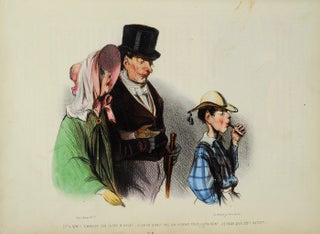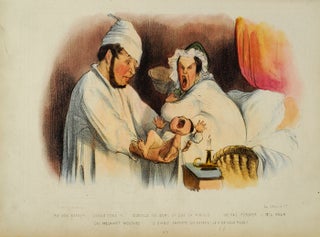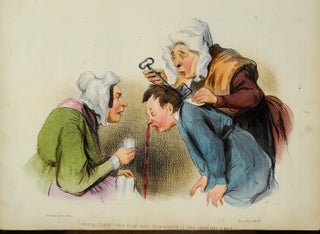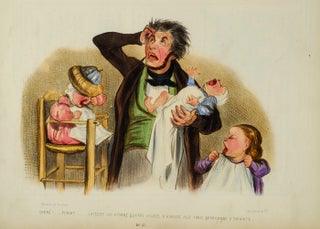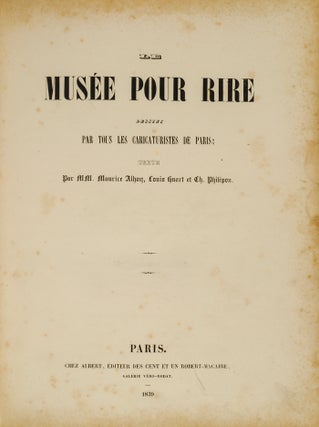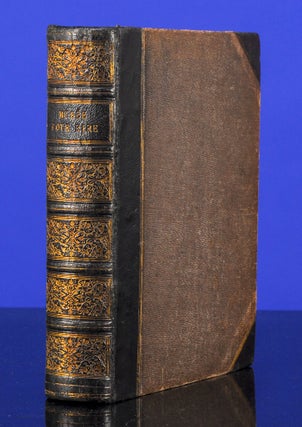Musée pour rire, Le
Paris: Chez Aubert, 1839. Item #02253
With 150 Hand-Colored Lithographs,
including Forty-Five by Honoré Daumier and Forty-Two by Gavarni
[DAUMIER, Honoré, Gavarni, and others, illustrators]. [ALHOY, Maurice, Louis Huart, and Ch[arles] Philipon, editors]. Le Musée pour rire. Dessins par tous les caricaturistes de Paris; Texte par MM. Maurice Alhoy, Louis Huart et Ch. Philipon. Paris: Chez Aubert, Editeur des Cent-et-Un Robert-Macaire, 1839-1840.
First edition. Three quarto volumes bound in one (10 x 7 5/8 in; 251 x 193 mm.). [1, half-title], [2, title], [600] pp. With 150 numbered hand-colored lithographs heightened with gum arabic by Honoré Daumier (forty-five), Gavarni (forty-two), Frédéric Bouchot (twenty-two), Victor Adam (ten), Platier (seven), Benjamin [i.e. Benjamin Roubaud] (four), Bourdet (three), Pruche (three), Platel (two), Grandville (two), Edme-Jean Pigal (two), Alophe Menut (two), Charles Vernier (two), Charles-Joseph Traviès (one), and others.
Bound ca. 1886-1890 by James Screeton of Hull (with label to rear pastedown) half black pebbled morocco over gray-brown cloth. Elaborately gilt tooled compartments, gilt-rolled raised bands. All edges gilt. Some foxing and toning throughout, but still a very good copy.
“The house of Aubert was ingenious in marketing its products. Its lithographs…were published one by one in periodicals like Le charivari and together in suites by the same artist without letterpress. Still a third form of publication was in albums made up of lithographs by several artists with accompanying texts. These collections most commonly took the form of volumes with the generic title Paris comique, which consisted of twenty colored lithographs accompanied by quite unrelated texts. Aubert remarked that the resulting hodgepodge had ‘a plan that is easy to follow, for it consists in not having any,’ and in fact this was indeed a frugal procedure for reusing old texts and already published plates. The interest of the various volumes of Paris comique resides entirely in the lithographs they happen to contain. It can be considerable, however, since Daumier and Gavarni are the predominant artists. Le musée pour rire represents a more considerable effort on the part of Aubert. To accompany 150 lithographs, including forty-five by Daumier (among them twenty-seven from Croquis d’expression[s] and eight from La galerie physionomique) and forty-two by Gavarni, new commentaries were commissioned on each plate, all except two by Alhoy and Huart. Daumier’s lithographs were trimmed slightly, and their captions were relettered. The designs of the other artists were provided with decorative frames. The whole was then published in three handsome volumes, and in copies with expert contemporary coloring like this one, Le musée pour rire is among the freshest and most attractive of romantic illustrated books” (Ray, The Art of the French Illustrated Book).
Le Musée pour Rire “contained 150 lithographs by Daumier, Gavarni, Bouchot, Traviès etc. These are re-impressions (some of them in mirror image), which had previously already been used for publication in Le Charivari. Most prints of the series ‘Croquis d’expressions’ are contained in the book. The name of the series is missing and the texts were printed in a different type than in the original Charivari version. We do not consider these prints original lithographies, but rather prints ‘after Daumier’”.
James Screeton was the son of bookbinder William Screeton of Hull. It appears that he was partner of binder William Wardell until opened his own shop in 1886.
Ray, The Art of the French Illustrated Book, 164.
Price: $9,500.00

 I have been in the rare and antiquarian book business for over forty years; my family has been in the rare books business since 1876. Rare books are in my blood.
I have been in the rare and antiquarian book business for over forty years; my family has been in the rare books business since 1876. Rare books are in my blood.

